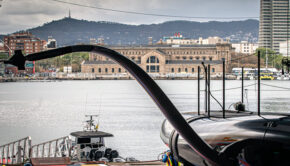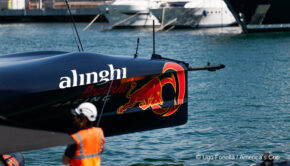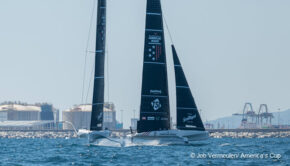Familiar Shoals for America’s Cup: A Spat Over Rules
Published on April 20th, 2015
By Christopher Clarey
The America’s Cup appeared to have regained momentum in San Francisco Bay in September 2013, but 19 months later; it looks in need of a gust of wind.
The last Cup ended with one of the most remarkable comebacks in any sport as Oracle Team USA, only one race from defeat, rose from the depths of an 8-1 deficit against Emirates Team New Zealand to defend the Cup with eight straight victories.
It was thrilling as well as spectacular because it was contested in 72-foot foiling catamarans with wing sails that often looked more like flying machines than yachts. Yet for all the risks, the outcome seemed to create a solid platform for a venerable sailing event that had been badly rattled by legal disputes, declining interest from challengers and, worst of all, the death of the British sailor Andrew Simpson in a training accident a few months earlier.
Instead, the Cup, which dates to 1851, has returned to too-familiar waters with more squabbles, money worries, challenger withdrawals and controversial changes. There are also concerns about the Cup’s relevance and appeal in a global sports marketplace full of sharp elbows and much easier sells.
Luna Rossa, the Italian team that has been one of the pillars of the modern Cup, withdrew this month. Its owner, Patrizio Bertelli, who runs the Italian company Prada, disapproved of the challengers’ vote to downsize to 48-foot catamarans for the next Cup, in Bermuda in 2017. (The rules for 2017 had previously provided for 62-foot catamarans.)
Team New Zealand, another pillar, is also not yet a sure thing.
Team Alinghi, led by the Swiss billionaire Ernesto Bertarelli, had been a mainstay of the competition but has not returned since it lost the Cup to Oracle in 2010, after a long legal battle with the Oracle team owner Larry Ellison.
“I hope the world gets to understand that when I’m not racing, and when Bertelli pulls the plug, when Team New Zealand is struggling, it is all because these people do not behave like sportsmen,” Bertarelli said in a telephone interview. “Sports is about setting rules, having an independent referee and going at each other fairly.”
Some Oracle officials and sailors, including the skipper James Spithill, argued that to the contrary, the goal was a more equitable Cup in which more teams would have a chance to take part and be competitive.
With Alinghi as defender, the full-scale Cup in 2007 in Valencia, Spain, had 11 challengers. There were three in 2013, and for now, there are only four for 2017.
“It’s a real shame; I consider Patrizio Bertelli a friend, a good friend,” said Spithill, formerly the helmsman for Luna Rossa. “But I truly believe we have to think about the future of the event. And the bigger boats, we’ve kind of proven the last couple of Cups that while sure, they are pretty spectacular, it just really is unsustainable. We need to attract new teams, and we want to have a boat now that is locked in for the next Cup after this one.”
It should be noted, in the litigious context of the Cup, that no formal agreement yet exists to contest the next edition after 2017 in the same 48-foot catamarans.
Bertarelli and Bertelli maintained that the problem for this round was not the smaller boat, which most viewers will have difficulty distinguishing from a 62-footer on television, but changing the rules midstream. Bertelli, who has now officially withdrawn and is dismantling his team’s base in Cagliari, Italy, believed he had a design advantage with the 62-foot boat, called the AC62, before the switch. Full Report









 We’ll keep your information safe.
We’ll keep your information safe.